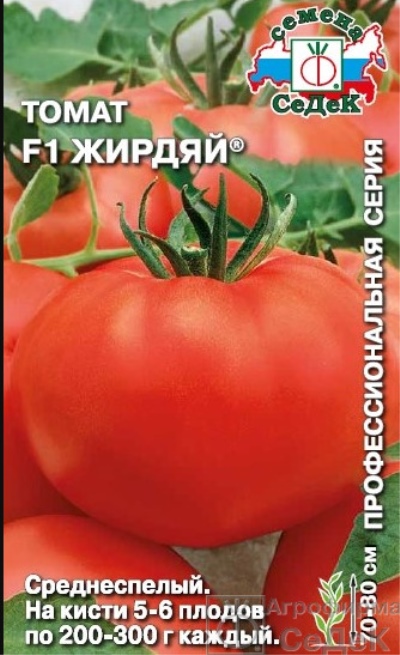
- Authors: Lukyanenko A.N., Dubinin S.V., Dubinina I.N.
- Year of approval: 2010
- Category: hybrid
- Growth type: determinant
- Appointment: fresh consumption, for juice, for ketchup and tomato paste
- Ripening period: mid-season
- Ripening time, days: 107-115
- Growing conditions: for open ground, for film greenhouses
- Marketability: high
- Bush size: medium-sized
Among the many types of tomatoes grown on farms and in gardens, mid-season varieties with weighty fruits are especially popular. One of these is the hybrid tomato Fat, which belongs to the universal class.
Breeding history
Vegetable culture Zhirdyai is the result of the painstaking work of a group of domestic breeders (Dubinin, Lukyanenko and Dubinin). A variety of mid-ripening tomatoes was bred in 2009. In 2010 it was entered into the State Register and approved for use. Recommended for cultivation in all climatic zones of Russia, both in open ground and in greenhouses.
Description of the variety
The nightshade culture is a medium-sized determinant bush, reaching a height of 70-80 cm. It is characterized by compactness, since the bush is medium-spreading, with a moderate thickening of dark green foliage, a simple type of inflorescence, strong stems and a powerful root system. During cultivation, it requires the formation of 1-2 stems, partial pinching and mandatory garter, since the berries of the variety are large enough, which can lead to deformation or breakage of the stems.
The main qualities of the fruit
The Fat tomato grows to a large size - the average fruit weight is 200-300 g. The tomato shape is standard - flat-round, without ribbing and other irregularities. The color of the ripe fruit is uniform, deep red. Unripe berries are light green in color. The tomato skin is dense, with a glossy finish. It is the density of the peel that protects tomatoes from cracking, and also guarantees long-term storage and transportation without significant losses.
Taste characteristics
Tomatoes are endowed with excellent taste - pronounced sweetness with barely noticeable sourness. The aroma of the fruits is moderate, and the pulp is juicy, dense, with a small amount of seeds. Despite the fact that it is a salad variety, it is ideal for canning, processing into dressings and juices.
Ripening and fruiting
Seed culture Zhirdiai belongs to the mid-season. From the moment of emergence to the first ripe tomatoes, 107-115 days pass. Ripening of berries occurs gradually, and the fruiting period is somewhat delayed, which allows you to enjoy fresh tomatoes for a long time. In the stage of full ripening, the tomatoes do not crumble. In addition, they can be harvested unripe (yellow-orange color), as they can ripen at room temperature.
Yield
The yield of this variety is one of the many advantages. Subject to the rules of agricultural technology from 1 m2, you can get up to 8.2 kg of tomatoes. In greenhouses, yields can be even higher.
The timing of planting seedlings and planting in the ground
Sowing seeds for seedlings is recommended in the first decade of March. Before sowing, the seeds are disinfected and germinated a little. Cultivation is carried out in boxes in a warm, well-ventilated and well-lit area. With the appearance of 2-3 true leaves, a dive is performed (seating in separate pots). 10-14 days before planting in a permanent place of growth, it is recommended to carry out the hardening procedure of the plant.
In open ground, bushes, which are 60-70 days old, are planted in the first half of May, when the air and soil are sufficiently warmed up.

Growing tomato seedlings is an extremely important process, because it largely depends on whether the gardener will be able to harvest at all. All aspects must be taken into account, from seedbed preparation to planting in the ground.
Landing scheme
So that the bushes do not shade each other, it is recommended to plant no more than 3-4 plants per 1 m2. If you form a bush into 2 stems, then you need to place 2-3 bushes. The optimal layout for planting is 60x40 cm.

Growing and care
It is necessary to grow a culture in a well-sunlit area. The soil is cleared of debris and weeds, dug over, which provides good air permeability, is moistened and fertilized. Caring for Fat tomatoes includes watering, feeding, shaping and garter, disease prevention.




A plant needs different micronutrients at each stage of growth. All fertilizers can be divided into two groups: mineral and organic. Folk remedies are often used: iodine, yeast, bird droppings, eggshells.
It is important to observe the rate and period of feeding. This also applies to folk remedies and organic fertilizers.
Disease and pest resistance
The plant has good immunity. The variety is extremely rarely affected by diseases such as verticillosis and apical rot.


Resistant to adverse weather conditions
The culture is stress-resistant, therefore it endures temperature fluctuations, sudden changes, cold snaps and drought.
Growing regions
The variety can grow in any climatic zone. Today, the culture is massively grown on the territory of the Russian Federation, Ukraine, Belarus, Moldova.
Review overview
Fat tomatoes are loved by both summer residents and commercial farmers. First of all, the variety impresses with its unpretentious care, high yields, long fresh storage life, as well as versatility. Along with the advantages of the variety, there are also disadvantages, including a special feeding scheme and the need for a garter.

























































































